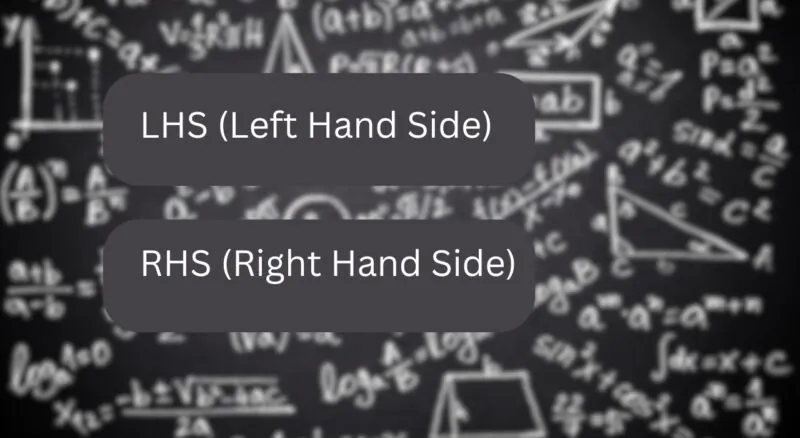
Share Post:
As you venture into the world of mathematics, you’ll often encounter a series of acronyms. Think of them as shorthand notes, each containing a world of concepts and ideas within a few letters.
These are not just for convenience; they encapsulate some of the most profound ideas in math, giving you a shortcut to understanding complex theories and concepts. In this blog post, we will unearth the meaning and significance of more than thirty such math acronyms. Let’s embark on this exciting journey!
Table of Contents
ToggleBODMAS/BIDMAS/PEDMAS (Order of Operations)
Mathematical expressions require a specific sequence of operations to ensure consistency in results. Without a defined order, calculations would produce varying outcomes depending on the sequence followed.
The order of operations eliminates confusion by providing a structured approach to solving equations. Different acronyms, including BODMAS, BIDMAS, and PEDMAS, guide this process. Each represents the same fundamental principle but varies slightly in terminology based on regional preferences.
BODMAS Rule
BODMAS stands for Brackets, Orders, Division, Multiplication, Addition, and Subtraction. The rule ensures that calculations follow a strict sequence:
- Brackets always take priority, meaning operations inside parentheses must be solved first.
- Orders include exponents and roots, requiring calculations of powers or square roots before moving forward.
- Division and multiplication hold equal precedence and must be solved from left to right.
- Addition and subtraction follow last, also proceeding from left to right.
Misapplying this rule leads to incorrect results, making it essential for solving complex expressions accurately.
BIDMAS Rule
BIDMAS follows the same structure as BODMAS but replaces “orders” with “indices.” Indices refer to exponents and powers, commonly used in algebra and advanced mathematics. The process remains unchanged:
- Brackets first
- Indices (exponents and roots)
- Division and multiplication (left to right)
- Addition and subtraction (left to right)
BIDMAS is commonly used in British mathematics education, ensuring that equations maintain consistency across different problem sets.
PEDMAS Rule
PEDMAS is a widely recognized variation used in North America, where “orders” or “indices” are replaced with “exponents.” The sequence of operations does not change:
- Parentheses first
- Exponents (powers and roots)
- Division and multiplication (left to right)
- Addition and subtraction (left to right)
LCM and HCF/GCD (Number Theory)
In number theory, two critical math acronyms that are commonly used are LCM (Least Common Multiple) and HCF or GCD (Highest Common Factor or Greatest Common Divisor).
The LCM (Least Common Multiple) of two or more integers is the smallest integer that is evenly divisible by each of the integers. The LCM can be found for any number of integers, and it plays a critical role in solving problems involving repetitions or cycles.
The HCF Highest Common Factor/Greatest Common Divisor) or GCD of two or more integers is the largest number that divides each of the numbers without leaving a remainder. It is a fundamental concept in number theory and is used extensively in algebra.
RHS and LHS (Algebra)
In algebra, two essential math acronyms that you will frequently encounter are RHS and LHS, representing the two sides of an equation.
RHS (Right Hand Side)
In an equation, the term on the right side of the equals sign is known as the RHS. It signifies the output or result of the operations performed on the variables.
LHS (Left Hand Side)
Conversely, the term on the left side of the equals sign is known as the LHS. It represents the expression or the operations that need to be performed on the variables.
If you’re just starting with algebra, understanding LHS and RHS is essential. Check out this introductory guide to algebra to explore more.
SOHCAHTOA (Trigonometry)
In trigonometry, the acronym SOHCAHTOA is an essential mnemonic that represents the fundamental relationships between the sides of a right triangle and the trigonometric ratios.
SOH stands for Sine equals Opposite over Hypotenuse. It defines the ratio of the length of the side that is opposite to the angle to the length of the longest side of the triangle (hypotenuse).
CAH stands for Cosine equals Adjacent over Hypotenuse. It represents the ratio of the length of the side next to the angle to the length of the hypotenuse.
TOA stands for Tangent equals Opposite over Adjacent. It represents the ratio of the length of the side opposite to the angle to the length of the side next to the angle.
DMS (Angle Measurement)
In geometry, the acronym DMS is used to denote a method of measuring angles. DMS stands for Degrees, Minutes, and Seconds, which are traditional units of measuring angles.
Degrees are the primary unit for measuring angles in the DMS system. A complete circle is divided into 360 degrees, and a right angle measures 90 degrees.
In the DMS system, each degree is subdivided into 60 minutes, and each minute is further divided into 60 seconds. This system allows for precise measurements of angles.
FOIL (Algebra)
In algebra, the acronym FOIL (First, Outer, Inner, Last) is used as a mnemonic to remember the steps to multiply two binomials. The FOIL method stands for First, Outer, Inner, and Last. It means that the first terms of each binomial are multiplied together, then the outer terms, followed by the inner terms, and finally, the last terms of each binomial.
AAA, SAS, SSS (Geometry)

In geometry, especially when dealing with triangles, the math acronyms AAA, SAS, and SSS are often used to refer to the conditions that can determine similarity or congruence between two triangles.
AAA is a criterion for the similarity of two triangles, meaning if the corresponding angles of two triangles are equal, the triangles are similar.
SAS and SSS are criteria for the congruence of two triangles. SAS states that if two sides and the included angle of one triangle are equal to two sides and the included angle of another triangle, the triangles are congruent. SSS states that if the three sides of one triangle are equal to the three sides of another triangle, the triangles are congruent.
CPCTC (Geometry)
In geometry, the acronym CPCTC (Corresponding Parts of Congruent Triangles are Congruent) is used to denote a property of congruent triangles. CPCTC stands for Corresponding Parts of Congruent Triangles are Congruent. It is a fundamental property of congruent triangles stating that if two triangles are congruent, then their corresponding parts (sides and angles) are also congruent.
PEM (Statistics)
In Statistics, the acronym PEM (Point Estimate of the Mean) is used to denote a method for calculating the mean of a data set. PEM stands for Point Estimate of the Mean. It refers to the method of using the sample mean as the point estimate of the population mean.
ACF and PACF (Statistics)
In time series analysis, which is a part of statistics, two essential math acronyms are ACF and PACF.
ACF stands for Autocorrelation Function. It’s a tool for identifying repeating patterns in a data set. It quantifies the correlation between observations in a time series and the corresponding observations from previous periods.
PACF, or Partial Autocorrelation Function, measures the correlation between observations at two points in time while controlling for any correlations due to the terms at intervening time points.
QED (Mathematical Proofs)
In the world of mathematical proofs, QED (Quod Erat Demonstrandum) is a common term used to denote the end of a proof. QED stands for Quod Erat Demonstrandum, a Latin phrase that translates to “what was to be demonstrated.” It’s traditionally placed at the end of a mathematical proof to indicate that the proof is complete.
PDF and CDF (Statistics)
When dealing with probability distributions in statistics, two key acronyms are PDF and CDF.
PDF (Probability Density Function)
PDF stands for Probability Density Function. For continuous random variables, the PDF is the function that describes the likelihood of different outcomes.
CDF (Cumulative Distribution Function)
CDF, or Cumulative Distribution Function, describes the cumulative probability that a random variable is less than or equal to a certain value.
LHS and RHS (Differential Equations)

In differential equations, similar to algebra, you will find the use of the math acronyms LHS and RHS.
LHS (Left Hand Side)
In a differential equation, the term on the left side of the equals sign is called the LHS. It typically represents the derivative or the rate of change of a quantity.
RHS (Right Hand Side)
The RHS, or Right Hand Side, of a differential equation, usually represents the forcing function or the external input to the system.
IID (Statistics)
In statistics, IID (Independent and Identically Distributed) is an acronym that defines a specific condition for a collection of random variables. IID stands for Independent and Identically Distributed. It’s a term used to describe a collection of random variables that have the same probability distribution and are mutually independent.
RREF (Linear Algebra)
In the field of linear algebra, the acronym RREF (Row-Reduced Echelon Form) is used to denote a specific form of a matrix.
RREF stands for Row-Reduced Echelon Form. It’s a form of a matrix in which the leading entry of each row is 1, all elements in the column below and above the leading entry are 0, and each leading entry is to the right of the leading entry of the row above it.
WLOG (Mathematical Proofs)
In mathematical proofs, WLOG (Without Loss of Generality) is a frequently used acronym.
WLOG stands for Without Loss of Generality. It is a phrase used to indicate that a statement or proof can be generalized without affecting the overall argument or result.
OLS (Statistics)
In statistics, OLS (Ordinary Least Squares) is a common method used in linear regression analysis. OLS stands for Ordinary Least Squares. It’s a method used in linear regression to estimate the parameters of the regression line by minimizing the sum of the squares of the differences between the observed and predicted values.
NLP (Optimization)
In the field of optimization, NLP(Nonlinear Programming) refers to a class of problems. NLP stands for Nonlinear Programming, which is a method used to solve optimization problems where the objective function or the constraints or both are nonlinear.
SVM (Machine Learning)
In machine learning, SVM (Support Vector Machine) is a commonly used algorithm for classification and regression analysis.
SVM stands for Support Vector Machine. It’s a supervised machine learning algorithm used for classification or regression analysis. It creates a hyperplane or set of hyperplanes in a high-dimensional space, which can be used for classification, regression, or other tasks.
More Math Acronyms…
| Abbreviation | Meaning |
|---|---|
| AC | Axiom of Choice |
| AGM | Arithmetic-Geometric Mean (inequality or function) |
| BLT | Bounded Linear Transformation Theorem |
| BMO | Function with the Bounded Mean Oscillation property, or the set of such functions |
| BVP | Boundary Value Problem |
| cadlag | Continue à droite, limite à gauche (right continuous with left limits) |
| CCC | Countable Chain Condition, Cartesian Closed Category |
| CFG | Context-Free Grammar |
| CMT | Continuous Mapping Theorem or Contraction Mapping Theorem |
| CNF | Conjunctive Normal Form |
| CRT | Chinese Remainder Theorem |
| DNF | Disjunctive Normal Form |
| FEM | Finite Element Method |
| FFT | Fast Fourier Transform |
| FLT | Fermat’s Last Theorem, Fermat’s Little Theorem |
| FOL | First-Order Logic |
| HOL | Higher-Order Logic |
| IFT | Inverse Function Theorem or Implicit Function Theorem |
| IVP | Initial Value Problem |
| KKT | Karush-Kuhn-Tucker Conditions |
| LP | Linear Programming |
| LS | Least Squares |
| MCMC | Monté Carlo Markov Chain |
| MCT | Monotone Convergence Theorem |
| MLE | Maximum Likelihood Estimator |
| MSE | Mean Squared Error |
| NPC | NP-complete |
| ODE | Ordinary Differential Equation |
| PDE | Partial Differential Equation |
| PID | Principal Ideal Domain |
| RE | Recursively Enumerable Language or Set |
| SDE | Stochastic Differential Equation |
| SOL | Second-Order Logic |
| SVD | Singular Value Decomposition |
| UFD | Unique Factorization Domain |
| WKB | Wentzel–Kramers–Brillouin Approximation/Method |
| ZF | Zermelo–Frankel Set Theory Axioms, without the Axiom of Choice |
| ZFC | Zermelo–Frankel Set Theory Axioms, plus the Axiom of Choice |
Final Words
I hope this blog post has served as a helpful guide to the wide range of math acronyms used in different fields of mathematics. The beauty of mathematics is that it is a universal language, one that can express complex ideas and abstract concepts in a simple and elegant manner.
The use of acronyms is just one example of how this language has been simplified and made more accessible for all to understand. Remember, these are just the tip of the iceberg; there are many more mathematical acronyms waiting to be discovered!











